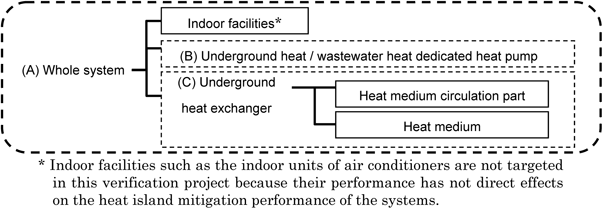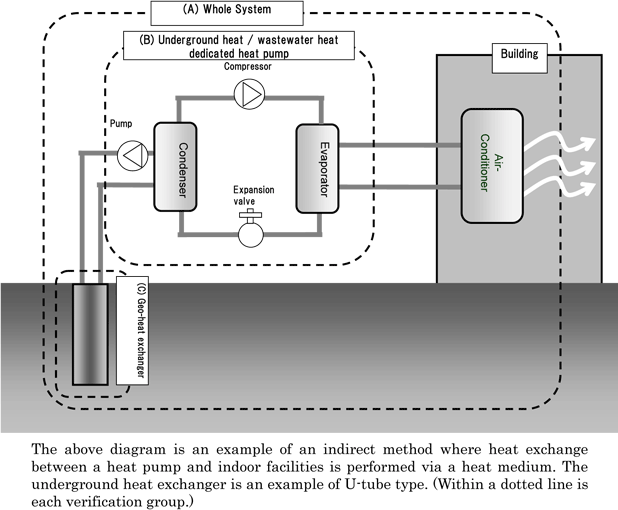Heat-Island Mitigation Technology Field (Heat Pump Air Conditioning Systems Using Underground Heat, Wastewater, etc.)
In this Heat-Island Mitigation Technology Field, technologies on “Heat Pump Air Conditioning Systems Using Underground Heat, Wastewater, etc.” are verified among the technologies to reduce artificial heat exhausted from offices, houses, etc.
“Heat Pump Air Conditioning Systems Using Underground Heat, Wastewater, etc.” are general systems which use underground heat, wastewater heat, etc., as heat sources, and efficiently provide air conditioning with a heat pump. These systems are composed of combination of multitier technologies. Verification applications from companies having a product or technology for each layer are assumed. Therefore, technologies to be verified are classified by layer as shown in Fig. 1.

Fig. 1 Whole image of the technologies to be verified
The purpose of this verification is to verify mitigation effects for heat island phenomena. The amount of heat exchanged with underground by the system, and power efficiency of the system are mainly measured. For this purpose, verification tests are performed for groups of technologies shown in Fig. (A) to (C). These groups are defined as “verification groups.” In the case of systems using wastewater heat, there is no underground heat exchange part. Therefore, verification groups are (A) and (B) only in such a case, and items that can be verified among them are selected as verification items.
- (A) Whole system for utilizing underground heat
- Whole technologies concerning the system, including a heat exchange well, indoor facilities, etc.
- (B) Underground heat / wastewater heat dedicated heat pump
- Water cooling heat pump assuming the use in the temperature range of underground or wastewater
- (C) Underground heat exchanger
- A system from a heat exchange well to just before a heat pump system, which is the scope of technologies that can be installed with technologies of civil engineering companies only.

Fig. 2 Schematic of the cooling operation of a heat pump air-conditioning system
technology using underground heat, wastewater heat, etc.
Heat Pump Air Conditioning Systems Using Underground Heat, Wastewater, etc.
These are technologies for air conditioning of houses using temperature difference between underground water (underground heat) and outdoor air. Underground water has a characteristic that its temperature is higher than that of outdoor air in winter, while it is lower in summer. Therefore, the efficiency of air conditioning becomes higher compared with the case using air as a heat source. In summer, this air conditioning method has another advantage that heat is not exhausted to ambient air during cooling operation. The method has the following two advantages that contribute to artificial exhaust heat reduction:
- [1]
- Heat from an indoor unit is exhausted to underground, not to ambient air, which is different from air cooling heat pumps (generic cooling equipment) that exchange heat with outdoor air. Therefore, the amount of heat exhausted to outdoor air is reduced.
- [2]
- In the case of heat pump air conditioning systems using underground heat, smaller heat exchangers can be used compared with generic air cooling systems because heat exchange is performed by water cooling. Therefore, energy for air conditioning can be saved, resulting in reduction of the amount of heat exhausted to outdoor air.
Heat-Island Mitigation Technology Field
Heat-Island phenomena are phenomena where the ambient temperature of the central area of a city becomes locally high (island-shaped temperature distribution). The followings are the main two causes of the phenomena.
- [1]
- Increase of artificial heat exhausted from human activities such as air conditioning systems, electric apparatuses, and automobiles
- [2]
- Increase of artificial coverings over the ground by decrease of green areas and water surfaces and by increase of buildings and pavements.
The phenomena have come to be widely known to the public as an environmental problem specific to cities.
Ministry of the Environment estimates that, among heat (sensible heat to the air) having an effect on temperature rise in Tokyo's 23 wards, heat caused by artificial exhaust heat occupies about 50%, and half of the artificial heat is generated from buildings (air conditioner, etc.).
Due to the heat island phenomena and the progress of global warming, heat environments in cities are getting worse. Improvement of heat environments within cities are an urgent issue. In particular, artificial heat exhausted from offices, houses, etc., are the main cause of temperature rise in big cities.
Reference: What is the “Outline of the Countermeasures against Heat Island Phenomena”?
In the “Outline of the Countermeasures against Heat Island Phenomena” laid down in March 2004, basic policies are presented to appropriately promote efforts of the national government, local governments, enterprises, residents, etc., for heat island mitigation measures, and specific measures to be taken are summarized. Pillars of the countermeasures include: [1] reducing artificial exhaust heat, [2] improving coverings over the ground, [3] improving urban forms, and [4] improving lifestyles.